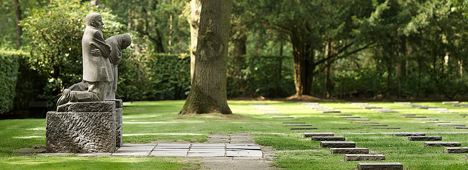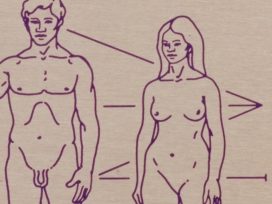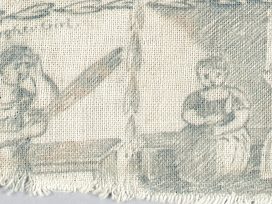That the fighting front, the realm of male aggressiveness, required an institutionalized outlet for male sexual drives seemed self-evident. (Roger Chickering)
Rapes occurred quite widely, but calculation of the total number is impossible given the difficulty of recording this crime. (John Horne, Alan Kramer)
War as a societal state
With contemporary historians like Gerd Krumeich assessing the World War from 1914 to 1918 as “one of the formative experiences of the century, perhaps even the decisive factor in shaping it”, an event that each generation examines anew “in the light of old insights and new experiences, and the theoretical approaches gleaned from their own lifeworld”, it would seem high time to ask about the extent to which this war a century ago influenced the gender hierarchy of the western world. Wolfgang Mommsen goes much further, identifying the First World War as, “in a certain sense, the fatal crisis of old bourgeois Europe”, as a result of which “major parts of pre-war orders and institutions were destroyed, but above all the social structures were changed substantially.” This raises the question of the extent to which these changes affected the way gender characters were shaped, how the sexes related to each other and their options for action. Three aspects are always elementary in determining the subject status of the sexes in a given social system: firstly, the question of economic independence, that is, the possibility of supporting oneself financially; secondly, the question of citizenship rights and possibilities for participating in the public sphere, and thirdly, the question of sexual self-determination, that is, of control over one’s own body and reproductive capacity. Accordingly, it must be asked to what extent the First World War influenced, changed or reorganized and fortified the gender hierarchy based on complementary public and private spheres.

Käthe Kollwitz’s “The Grieving Parents” (1932), Vladslo German war cemetery, Belgium. Photo: milo-profi photography / visitflanders. Source:Flickr
Characteristic for the First World War was, first of all, the integration of the entire society for the purpose of waging war, an integration that made obsolete not only classical conceptions of the spatial segregation of the theatres of war, but also the allocation of tasks according to a gendered division of labour. In lieu of which, the war took on highly complex, manifold meanings for the men and women of the states at war: “In most states, modern national armies emerged over the course of the nineteenth century, many of them based on the introduction of general compulsory military service. In the early twentieth century, the mobilization of expanding sectors of the male population for war, and ever larger parts of the female population on the ‘home front’, peaked in the first industrialized and technologically highly advanced ‘people’s war’, World War I.” In the scenario of the First World War, women can be identified as the first “home front”, where they were assigned positions that lent meaning to the conflict – the hero’s mother, the devoted wife and the sweetheart longingly awaiting her lover’s return – and where they replaced male workers and provided for their families. As nurses in military hospitals at the front, as Etappenhelferinnen in the first Women’s Army Corps, as farmers to whom prisoners of war were allotted as workers, women were not only close to the field of soldiers’ experience and to what soldiers experienced and did in war, they were actually directly involved.
Characterizing the First World War as a “so-called people’s war legitimated by national interests” implies perceiving it as a state of society, the defining of which, as Ute Daniel establishes, would first require clarification as to how it was perceived as an event by the various societal groups, classes, and so on, and with which consequences, that is “in a sense, how many First World Wars there were and what each of them was like.”
What needs investigating is this: how the various actors were positioned over the course of the conflict, which options and which impositions the war had in store for them, and how it served to establish, modify or overcome structural orders of society – decisively so in the case of the structural order of a gender hierarchy and a gender-specific division of labour that complemented one another. Further attention should be paid to what sacrifices the war demanded from whom, and what rewards it had in store for whom.
In the first place, merely reciting the national identification that unified the populace seemed sufficient to put divergent interests and social conflicts to rest by invoking an old-fashioned sort of “truce”, even if the worry was already palpable before 1914, “that the impending great European war, which many hoped for and others feared, but most expected sooner or later, could take on a new, previously unknown quality and undermine traditional political and societal arrangements.”
But the war euphoria of August 1914 is now received as a commonplace, despite doubts being raised occasionally as to its extent.
Wolfgang J. Mommsen describes the phenomena as “a tremendous flood of national enthusiasm, which was certainly borne primarily by the middle classes, but extended far beyond it to encompass nearly all broad layers of the population without exception”. Obviously, it also encompassed women. In all of the states at war, the younger generation surged ahead to volunteer for military service, and were frequently encouraged and even urged to do so by their mothers: “The serious political and social conflicts of the pre-war years seemed forgotten; the unity of the nation in the fight for the nation’s own self-assertion appeared to unify all classes and strata of the nation.” As the war progressed, however, the “truce” proved fragile; increasingly, it became a mere façade behind which the old political conflicts continued to be waged with a vengeance. Women played a key role in these struggles, above all through their contribution to maintaining the war economy, their strategically vital employment in the armaments industry and their fight for the just distribution of scarce foodstuffs. Yet these achievements initially brought them neither recognition as citizens with equal rights, nor any increased mobility. The state did grant soldiers’ wives material support, yet this was linked to a social system of control that combatted any “aberrations” in the form of autonomous social action.
Society’s recognition of their work/effort/performance did not result in women being regarded as subjects to be treated as equals and was still bound up with the attribution of gendered, often ambivalent characteristics to women. For instance, nurses in field hospitals at the front, stylized as desexualized “angels in white,” could easily mutate into frivolous amorous adventurers.
The hope, cherished primarily in the circles of the middle-class women’s movement, that patriotic commitment could break through women’s banishment to the private sphere and earn them recognition as citizens, equal access to education and training, and economic independence through employment were fulfilled only to a rudimentary degree. The heroes’ mothers and soldiers’ brides were obliged to motivate their sons and husbands to fight and persevere – yet they were still denied any recognition as equal players in society extending beyond imagined conceptions and self-portrayal.
War as a state of emergency
“But war is war, and so one must do things that previously one might have merely wanted to do.”
If at the beginning of the war it was assumed that the conflict would be limited to a brief intermezzo, it soon became clear how high the price of this first, greatly protracted industrialized mass war would be – and, that it would be borne not only by the combatants, but also the civilian population.
Although the use of propaganda, made possible by the new means of mass communication, succeeded in contributing to the war effort, such staging of reality by the media was not entirely able to conceal the horrors of aspects like the new scale of destruction introduced by automatic weapons. Even so, some effort was apparently required to direct the attention of war observers to the horrors inherent in the war.
Michael Geyer explicitly challenges us to think about a war history that speaks of death and, specifically, “as a central element of any analysis of the war, the mass death organized and accomplished by humans – the system, the act and the consequences of killing and being killed.” Thus he points out the central element upon which an understanding of war as a state of emergency is based. This understanding is borne by the inversion of the commandment, so essential in civilian life, “Thou shalt not kill”, such that it becomes an imperative located in the rulebook of war, to kill, and to be ready to have oneself killed. It thus concerns an ultimate form of the use of force, which had to be exercised and accepted with the introduction of universal conscription for men from all classes and sectors of society. Not only subordination, discipline and soldierly courage were called for, but also the willingness to make sacrifices, to fight and die for the Fatherland, and voluntarily choose patriotic death as a hero.
The imperative to kill and be killed, the application of which necessitated being trained and drilled accordingly, entails both impositions and the possibility of transcending boundaries: withstanding and overcoming mortal fear, and experiencing the power of being able to kill. Many opportunities to identify with contemporary normative assumptions were provided, not only to oblige soldiers to participate in the war, but also to motivate them for the art of warfare. In addition to narratives concerning the defence of honour and Fatherland and of women and children on the home front, traditional conceptions of the rite of passage to male adulthood through proving oneself as a warrior also seemed to be suited to the First World War. Here, too, the classical narrative of the hero who conquers his foe and valiantly faces his death, initially blinds one to the individual acting and being acted upon in a situation of ultimate extremes so that it omits, in Elaine Scarry’s words, “the fact of injuring” and tones down death and pain in favour of a fantasy in which war appears as a fair, honourable competition. However, outlining an honourable martial masculinity in this way appears insufficient to enable men, as Joanna Bourke describes it so vividly, “to cope with the problem of the transition from an identity based upon the commandment ‘Thou shalt not kill’ to one in which killing was the measure of identity and self-worth.” A closer look at the battlefield of a war assists in understanding what is at stake, should Clausewitz’s frictions of war observed there be mastered and diverted into combat-effective behaviour. In a situation determined by “extreme affects – from the stupor of mortal fear to the furore of battle frenzy”, the purpose is to steer action by way of a “contingency management” intended to “orient all activities toward strengthening one’s own potential for violence or weakening that of the enemy.”
How individuals exposed to affects of this kind actually perform in the space of contingency of the battlefield requires much more precise description. For instance, even a conceivable reluctanceto kill or be killed in the name of the state or the nation must be considered: “This reluctance,” affirms Michael Geyer, “is generally overlooked.” The history of “involuntary soldiers” – in contrast to that of “voluntary warriors” – has yet to be written. How such reluctance was dealt with during and after World War I can be seen in the way shell shock and the soldiers who suffered from it were treated. Mental disorders, like those triggered by passive perseverance and the permanent threat of death through artillery fire during trench warfare on the Western front in World War I, were and remain taboo or were, at the very least, reinterpreted. For instance, military psychiatrists certified “the so-called shell-shocked” as subject to “psychosomatic hysterical symptoms” and accused them of “an (unconscious) escape from the war into illness.” Proponents of the condition’s psychological origins suggested a genetic predisposition, an internal defence against military service as well as an emotionally unstable constitution. There is no doubt that the emergence of symptoms imputed to the “shell-shocked” was based on a repertoire of gender-specific characteristics that are scarcely reconcilable with conceptions of masculinity in which war functions as the genuine opportunity to realize and express male characteristics.
Dirty secrets
Also interesting in this context is the assumption that the will determines how the soul reacts to external stimuli and internal processes. Insight into how the will can be prodded toward transforming “external stimuli” experienced in war into internal processes experienced as positive/affirmative/exciting can be tracked in practices associated with martial atrocities that are certainly known about, but widely considered taboo.
Joanna Bourke describes killing rituals observed on scores of battlefields that appear downright carnivalesque, which soldiers experienced as exhilarating. In her assessment, “they helped create individual identity as a ‘warrior’ engaged in a life-and-death-struggle, and they helped cement group bonds – comradeship between men, all of whom were ‘set apart’ from both their pre-war personas and civilian society ‘back home’ by acts of violence.” Military officials officially prohibited all too familiar practices like taking and exchanging explicit pictures, or the obscene treatment of body parts and bodies of the dead enemy, while nevertheless “overlooking” such “authorized transgressions,” since they were regarded as necessary for “effective combat performance”, as a sign of “combat effectiveness.” What lends meaning to these seemingly pointless actions that appear to constitute a surplus of cruelty? Apparently, they serve to promote the extremely taboo and yet unmistakable fact that the “license to kill” offers a highly attractive, exciting opportunity to transgress a boundary. “In the killing frenzy of combat the fact that the slaughter of fellow human beings could elicit feelings of satisfaction in addition to fear was”, writes Joanna Bourke, “the dirty secret that dared not be uttered after the war if combatants were to settle back to their calm civilian lives, un-brutalized.” This raises the question of what incentives were necessary to ensure that such experiences of boundary transgressions remained secret, and whether they might have an impact after all, becoming incorporated in a repertoire of options for action.
The enthusiasm with which the outbreak of war was greeted in parts of the population (and certainly also by women), appears to be due in part to a euphoria of upheaval, which was borne by an enthusiasm for violent transgressions of norms and boundaries. “The talk was of ‘the freedom of men’, who should not be deterred by any women nor by any moral of guilt when the point was to make ‘people tremble’: ‘Beyond good and evil for once! Human, inhuman, super-human at last’.”
Just how strong the erotic connotation of an aesthetics of martial violence was, is apparent in the examples of unfettered cults of masculinity in which violence was stylized as the true climax of orgiastic fulfilment. For instance, Hans Mommsen quotes Ernst von Salomon, who describes his participation in battles as follows: “The rifle trembled between my knees like an animal […] Was it not as if I sensed in the juddering metal parts of the rifle how it fired into warm, living human bodies? Satanic air, as if, am I not one with the rifle? […] On into the chaotic mass, here a gateway is erected – mercy comes to him who passes it.” And in another passage: “The rifle reared up and darted like a fish; I held it tight and tenderly in my hand, and gripped its trembling flanks between my knees and shoved one strap and then a second, right through.”
In this example, realizing the power to kill through the use of a weapon mutates into a sexual act in itself, such that a further object of sexual desire appears to be virtually superfluous.
“The commander was quite satisfied, and we were even supposed to receive a reward. Perhaps the Iron Cross along with it. And then there are young girls here who are nice to deflower.“
Roger Chickering asserts, in the “Gender” section of a chapter entitled “The war embraces all,” the following: “That the fighting front, the realm of male aggressiveness, required an institutionalized outlet for male sexual drives seemed self-evident.” In so doing, he cites a narrative that draws a straight line between male aggression and masculine “sex drive.” The self-evidence with which this narrative is presented insinuates that this connection is an inevitable attribute of a male sexual practice of exerting sexual violence, which everyone knows about without having to speak of it or, in the case of the victims, being able to speak of it.
In their comprehensive study on the events of World War I in Belgium, John Horne and Alan Kramer state, “Rapes occurred quite widely, but calculation of the total number is impossible given the difficulty of recording this crime.” What is the nature of the difficulty? For one, it is apparently tacitly agreed that, in contrast to other acts of violence, violent sexual offences are located on the interface between an act of war and an act that is also practiced in civilian life: “War is one occasion when rape scripts diverge from the individualist canon of legal and psychiatric practice and enter fully into everyday mass culture.” And here is the wording in the reports of the Allied Investigation Commission cited by the authors: “All the Allied commissions considered that rape had happened with what the French termed ‘unheard-of frequency.’ They were, however, uncertain how to account for it. They felt it had less connection than other types of ‘atrocity’ to what they saw as the German policy of systematic terror and they placed it at the individualist end of the spectrum of war crimes” (author’s emphasis).
On the other hand, the narrative refers to the role of the victim in the process of keeping such acts secret, or even taboo: “The shame felt by the victims tended to cause understatement of its incidence. […] As the Belgian Commission commented, cases of rape ‘are naturally hidden by the families'” (author’s emphasis). This “consideration” of the “shamed” victims of sexual violence makes sense only if the deeds themselves were regarded as self-evident and unavoidable, and the victims were assumed to share the responsibility for their occurrence.
“THE FEMALE ASSISTANTS:
We, to delight the armed forces,
Enlisted army whores,
now turn their backs on you
as the brigade of lemurs.
Sacrificing heroic yearning,
infected by your courage,
roses bloom on our cheeks
and syphilis in our blood”
It is a decisive prerequisite for being able to record the practice of exerting sexual violence in war to break with this narrative of self-evidence/unavoidability and shared responsibility in favour of a perspective that examines where, when and how women and men encounter each other in war, how men and women are positioned and what scripts of sexual availability versus sexual self-determination determine the attitudes of the players in war.
Gender stereotypes function so as to secure a certain social order. They belong to the deep structures of social knowledge, in which what is everyday and presumably natural is stored – unscrutinized circumstances that are “known” intuitively, but seldom reflected upon, let alone questioned. To these unquestioned circumstances must be attributed the role violence plays in the structuring of social relationships, and in this case, relations between the sexes especially.
Against this background, the perpetration of sexual violence – be it contingent on a space of opportunity, or specifically integrated in combat operations – can be read as a means to position oneself as superior to a defeated victim/enemy. It is neither self-evident nor unavoidable, nor indescribable – it can be described and detected as a tried and true means to an end.







